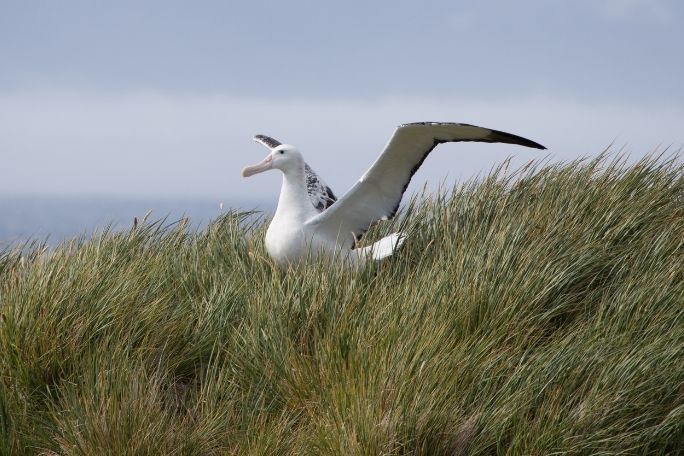Lesson summary
In this lesson, students explore the interconnected characteristics of a distinct region by investigating a recent case study. By studying the Shy Albatross students will learn about the flow-on effect of a variety of environmental changes and how geographical data has been used to protect this species. The class will then use this learning to write an article that engages the rest of the school in a program to monitor and protect local biodiversity.
Learning intentions:
Students will...
- understand how a species can be linked to its local environment
- understand how changes in the environment could affect a species
- know that long-term data can help inform environmental management
Success criteria:
Students can...
- concisely summarise geographical research from reliable resources
- make and justify connections between environmental threats and likely impacts on a species
- communicate the need for citizen science in an article written for an audience of their peers
Lesson guides and printables
Lesson details
Curriculum mapping
Australian curriculum content descriptions:
Year 9 Geography:
- Distribution and characteristics of biomes as regions with distinctive climates, soils, vegetation and productivity (ACHGK060).
- Human alteration of biomes to produce food, industrial materials and fibres, and the use of systems thinking to analyse the environmental effects of these alterations (ACHGK061).
- Apply geographical concepts to synthesise information from various sources and draw conclusions based on the analysis of data and information, taking into account alternative points of view (ACHGS068).
- Present findings, arguments and explanations in a range of appropriate communication forms, selected for their effectiveness and to suit audience and purpose; using relevant geographical terminology, and digital technologies as appropriate (ACHGS070).
Year 10 Geography:
- Select ONE of the following types of environment as the context for study: land (e.g. forests, deserts, grasslands, farmland), inland water, coast, marine or urban. A comparative study of examples selected from Australia and at least one other country should be included (ACHGK0082).
- The application of systems thinking to understanding the causes and likely consequences of the environmental change being investigated (ACHGK073).
- Apply geographical concepts to synthesise information from various sources and draw conclusions based on the analysis of data and information, taking into account alternative points of view (ACHGS077).
- Present findings, arguments and explanations in a range of appropriate communication forms, selected for their effectiveness and to suit audience and purpose; using relevant geographical terminology, and digital technologies as appropriate (ACHGS079).
Syllabus outcomes: GE5-1, GE5-2, GE5-3, GE5-7, GE5-8, SC5-14LW.
General capabilities: Information and CommunicationTechnology (ICT) Capability, Critical and Creative Thinking.
Cross-curriculum priority: Sustainability OI.2.
Relevant parts of Year 9 Geography achievement standards: Students explain how geographical processes change the characteristics of places. They analyse interconnections between people, places and environments and explain how these interconnections influence people, and change places and environments. They predict changes in the characteristics of places over time and identify the possible implications of change for the future.
Relevant parts of Year 10 Geography achievement standards: Students explain how interactions between geographical processes at different scales change the characteristics of places. Students identify, analyse and explain significant interconnections between people, places and environments and explain changes that result from these interconnections and their consequences.
Unit of work: ClimateWatch: Citizen Science – Geography – Years 9 & 10.
Time required: 120 mins.
Level of teacher scaffolding: Medium – teachers will facilitate class discussions and a group research activity.
Resources required
- Student Worksheets (one copy per student)
- Data projector and connected internet-enabled device
- Enough internet-enabled devices to allow students to conduct paired research
- A range of whiteboard markers
Skills
- Collaboration
- Communication
- Community engagement
- Creativity
- Critical thinking
- Digital literacy
- Problem solving
Additional info
The lessons in this unit have been developed in partnership with Earthwatch.
Earthwatch developed the ClimateWatch program with the Bureau of Meteorology and The University of Melbourne to understand how changes in temperature and rainfall are affecting the seasonal behaviour of Australia’s plants and animals.


Welcome back!
Don't have an account yet?
Log in with:
By signing up to Cool.org you consent and agree to Cool's privacy policy to
store, manage and process your personal information. To read more, please see
our privacy policy here(Opens in new tab).
Create your free Cool.org account.
Many of our resources are free, with an option to upgrade to Cool+ for premium content.
Already have an account?
Sign up with:
By signing up to Cool.org you consent and agree to Cool's privacy policy to
store, manage and process your personal information. To read more, please see
our privacy policy here(Opens in new tab).